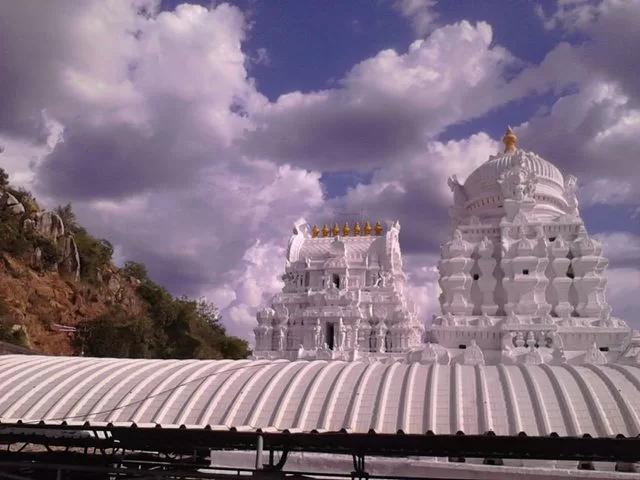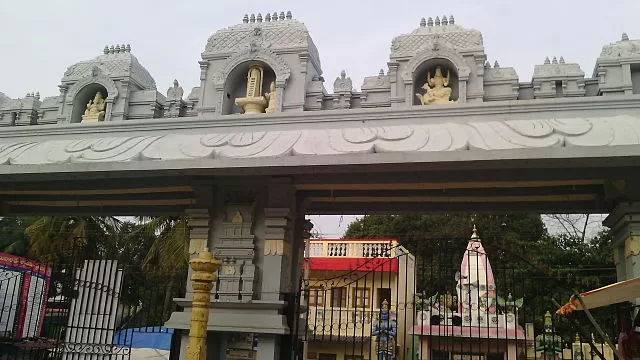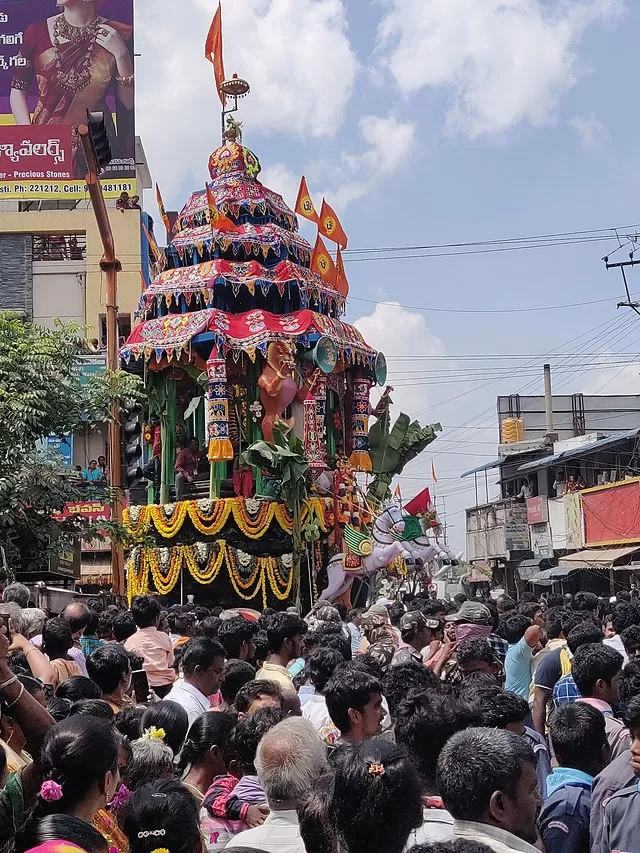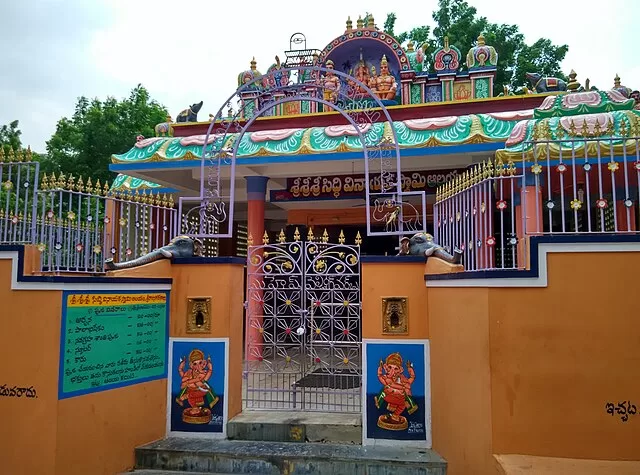Nestled in the enchanting state of Andhra Pradesh, Srikalahasti is a captivating town that exudes a rich cultural heritage and spiritual aura. Located on the banks of the River Swarnamukhi, this divine destination attracts thousands of devotees and travelers alike. In this article, we will embark on a journey to explore the mystical charm, historic temples, and natural beauty that make Srikalahasti a must-visit place.

The Legend of Srikalahasti Temple
Srikalahasti derives its name from three significant aspects: “Sri” referring to Goddess Parvati, “Kala” meaning spider, and “Hasti” symbolizing the elephant. According to the legend, a spider and an elephant worshipped Lord Shiva at this very spot, which bestowed them with salvation. The awe-inspiring Srikalahasti Temple stands as a testament to this divine event and has since become a revered place of worship for devotees seeking blessings and spiritual solace.
Architectural Marvels: Temples of Srikalahasti

1 The Srikalahasti Temple
At the heart of Srikalahasti lies the ancient and majestic Srikalahasti Temple. Dedicated to Lord Shiva, this architectural marvel showcases the exquisite Dravidian style of craftsmanship. Intricate carvings, towering gopurams (gateways), and detailed sculptures adorn this sacred abode, leaving visitors in awe of its grandeur. The temple’s main sanctum, housing the iconic Vayu Linga, attracts devotees from far and wide who believe in its divine power of healing and wish fulfillment.
2 Bhakta Kannappa Temple
The Bhakta Kannappa Temple is another significant pilgrimage site in Srikalahasti. This temple pays homage to Bhakta Kannappa, a devoted follower of Lord Shiva known for his unwavering faith. The temple premises echo with tales of his devotion and selflessness, inspiring visitors to embrace the virtues of faith and surrender.
3 Sahasra Linga Temple
Sahasra Linga Temple, meaning “temple of a thousand lingas,” is a unique shrine in Srikalahasti. The temple complex houses a vast collection of intricately carved lingas, each representing Lord Shiva. Devotees find solace in the serene ambiance of this temple, where they can offer prayers and seek blessings amidst the divine presence.
Natural Wonders: Pulicat Lake and Talakona Waterfalls

1 Pulicat Lake
For nature enthusiasts, a visit to Pulicat Lake is a must when in Srikalahasti. Located near the Bay of Bengal, this saltwater lagoon is the second-largest in India. Surrounded by lush greenery and dotted with migratory birds, Pulicat Lake provides a serene environment for birdwatching and boating activities. It is a paradise for nature lovers seeking tranquility and breathtaking views.
2 Talakona Waterfalls
Nestled amidst the dense forests of the Eastern Ghats, Talakona Waterfalls is a mesmerizing natural wonder near Srikalahasti. Cascading from a height of 270 feet, these majestic falls create a picturesque setting where visitors can indulge in the beauty of nature. Trekking enthusiasts can explore the surrounding trails and immerse themselves in the serene ambiance of the forest.
Exploring the Rich Heritage: Sri Subrahmanya Swamy
Temple

Srikalahasti is also home to the Sri Subrahmanya Swamy Temple, dedicated to Lord Murugan, the son of Lord Shiva and Goddess Parvati. This temple showcases exquisite sculptures and intricate architecture, reflecting the skilled craftsmanship of the bygone era. Devotees visit this temple to seek the blessings of Lord Subrahmanya, the deity revered for his valor and wisdom.
Festivals and Celebrations
1 Maha Shivaratri
Maha Shivaratri, the Great Night of Lord Shiva, is celebrated with great enthusiasm in Srikalahasti. Devotees throng the temples, engaging in prayers, devotional music, and dance performances throughout the night. It is believed that offering prayers on this auspicious day brings spiritual enlightenment and divine blessings.
2 Brahmotsavam
Brahmotsavam is a grand festival celebrated in Srikalahasti, marking the celestial wedding of Lord Shiva and Goddess Parvati. The town comes alive with vibrant processions, adorned chariots, and cultural performances. Devotees from far and wide participate in this joyous celebration, immersing themselves in the festive spirit and divine fervor.
Local Cuisine: Indulging in Srikalahasti Delicacies

A visit to Srikalahasti is incomplete without savoring the delectable local cuisine. The town offers a unique blend of Andhra Pradesh’s traditional dishes, known for their spicy flavors and aromatic spices. From the fiery Gongura pickle to the mouthwatering Pesarattu dosa, each dish tantalizes the taste buds and leaves a lasting impression of the region’s culinary prowess.
Accommodation and Travel Tips
When visiting Srikalahasti, there are several accommodation options available, ranging from budget-friendly guesthouses to luxury resorts. It is advisable to book in advance, especially during peak seasons and festival times, to ensure a comfortable stay. Additionally, hiring a local guide can enhance the travel experience by providing insights into the history, culture, and hidden gems of Srikalahasti.
Embracing the Spiritual Essence of Srikalahasti

Srikalahasti offers a spiritual sanctuary for seekers of inner peace and divine connection. Its historic temples, natural wonders, and vibrant festivals create an atmosphere of profound spirituality. Whether you are a devotee seeking blessings or a traveler in search of cultural immersion, Srikalahasti invites you to embark on a soul-stirring journey and discover the mystical charm it holds.
People also ask
What is Srikalahasthi famous for?
Srikalahasti is famous for its historic temples, particularly the Srikalahasti Temple dedicated to Lord Shiva. The town is known for its spiritual significance, attracting devotees from far and wide. It is also renowned for its natural wonders, including Pulicat Lake and Talakona Waterfalls. Srikalahasti’s rich cultural heritage, vibrant festivals, and delicious local cuisine add to its fame and allure as a must-visit destination in Andhra Pradesh, India.
How is Rahu Ketu pooja done in Srikalahasti?
Rahu Ketu Pooja is a significant ritual performed at the Srikalahasti Temple to seek the blessings of Lord Shiva and mitigate the negative effects of Rahu and Ketu, two celestial entities in Vedic astrology. Here is a general outline of how the Rahu Ketu Pooja is conducted in Srikalahasti:
- Dress Code: Visitors are required to adhere to the traditional dress code, which includes men wearing dhoti or traditional attire and women wearing saree or salwar kameez.
- Pooja Items: Devotees need to carry specific items for the ritual, including coconuts, betel leaves, betel nuts, flowers, turmeric powder, kumkum (vermilion), camphor, and incense sticks.
- Temple Entry: Upon entering the temple, devotees can purchase the required materials, including the special tickets for the Rahu Ketu Pooja, from the designated counters.
- Pooja Procedure: The ritual usually takes place in a designated area within the temple premises. The priest guides the devotees through the process, which involves offering prayers, chanting mantras, and performing specific rituals to appease Rahu and Ketu.
- Abhishekam: The main part of the Rahu Ketu Pooja is the Abhishekam, where the priest pours milk, water, holy water, or other sacred substances over the Rahu and Ketu idols while chanting prayers.
- Tailabhishekam: After the Abhishekam, devotees have the option to undergo Tailabhishekam, where they offer oil to Lord Shiva. This is believed to remove negative energies and bring prosperity.
- Archana and Prasadam: Following the main rituals, devotees can perform archana (offering prayers with individual names) and receive prasadam (sacred offering) from the temple priest.
It is important to note that the exact procedures and rituals may vary, and it is advisable to consult the temple authorities or priests for detailed instructions and any specific requirements before participating in the Rahu Ketu Pooja at Srikalahasti Temple.
Which God belongs to Srikalahasti?
Srikalahasti is predominantly associated with the worship of Lord Shiva. The main deity of the famous Srikalahasti Temple is Lord Shiva, who is worshipped in the form of Vayu Linga. The temple holds immense significance for devotees of Lord Shiva and attracts a large number of pilgrims seeking blessings and spiritual solace. Along with Lord Shiva, the temple complex also houses other deities, including Goddess Parvati, Lord Ganesha, and Lord Subrahmanya (Murugan). The divine presence of Lord Shiva in Srikalahasti makes it a revered destination for devotees and a center for religious and cultural activities.
What is the time of pooja in Srikalahasti?
In Srikalahasti, the temple follows a specific schedule for various poojas and rituals throughout the day. Here is a general overview of the pooja timings at Srikalahasti Temple:
- Suprabhata Seva: This is the early morning ritual that takes place before the temple opens for devotees. It usually starts around 5:00 AM and includes the waking up of the deity and offering prayers.
- Abhishekam: The Abhishekam, a ritualistic bathing of the deity, is performed during specific hours of the day. The timings may vary, but it is typically conducted in the morning hours.
- Sarva Darshan: This refers to the general darshan or viewing of the deity by devotees. It is available throughout the day, starting from the temple opening time.
- Rahu Ketu Pooja: The Rahu Ketu Pooja, which is a special ritual performed to alleviate the negative effects of Rahu and Ketu, has dedicated slots for devotees. The timings for the Rahu Ketu Pooja are usually specified by the temple authorities and can vary based on the day of the week and demand.
- Archana and Aarti: Archana, the offering of prayers with individual names, and the Aarti, the ceremonial waving of lights, are performed at specific intervals during the temple’s operational hours.
It is important to note that the exact timings of the poojas and rituals may be subject to change and are best confirmed with the temple authorities or through their official website or information channels. It is advisable to check the specific schedule before planning your visit to ensure you can participate in the desired poojas or rituals at Srikalahasti Temple.
Conclusion
Srikalahasti, with its divine aura and cultural heritage, stands as a testament to the rich history and spirituality of Andhra Pradesh. From the awe-inspiring Srikalahasti Temple to the tranquil Pulicat Lake and majestic Talakona Waterfalls, this town encapsulates the beauty of nature and the devotion of its people. Embark on a pilgrimage to Srikalahasti, immerse yourself in its spiritual essence, and create memories that will last a lifetime.
FAQs
1. What makes Srikalahasti so spiritually special?
Srikalahasti is often called the “Kashi of the South” because of its ancient temple dedicated to Lord Shiva. But what makes it truly unique is the powerful presence of Vayu Lingam (air element), one of the five Pancha Bhoota Lingams in India. It’s where people come not just to worship, but to heal their spiritual wounds.
2. Can I visit Srikalahasti even if I’m not religious?
Absolutely! While it’s a major pilgrimage spot, the town’s peaceful vibe, historic architecture, and the scenic Swarnamukhi River make it a great getaway for anyone. You don’t have to be religious to appreciate its energy and charm.
3. What’s the Rahu-Ketu Pooja everyone talks about?
Ah, that’s one of the main reasons people flock here! The Rahu-Ketu Pooja is believed to remove bad planetary effects like doshas or struggles related to career, marriage, or health. And Srikalahasti is one of the few places in India where it’s performed with such intensity and tradition.
4. How far is Srikalahasti from Tirupati, and can I do both in one trip?
Totally doable! Srikalahasti is just about 36 km from Tirupati — that’s roughly a 45-minute drive. Many travelers plan a combo spiritual trip to both, visiting Tirupati Balaji and then heading over to Srikalahasti for the powerful pooja rituals.
5. Is there anything else to explore in Srikalahasti besides the temple?
Yes! While the temple is the star attraction, there’s more to see. The Durgambika Temple, Bharadwaja Tirtham, and the scenic hill views around the town are worth a stop. Plus, the local markets are a great place to pick up handicrafts and traditional puja items.

